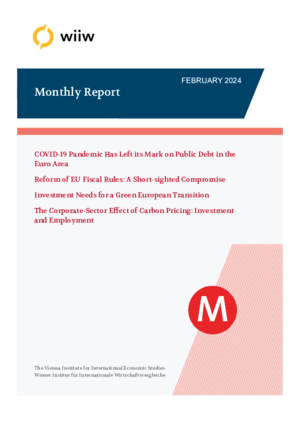Monthly Report No. 2/2024
Philipp Heimberger, Andreas Lichtenberger, Anna Matzner, Bernhard Schütz and Lea Steininger
wiiw Monthly Report No. 2, February 2024
51 pages including 1 Table and 27 Figures
- Chart of the Month: COVID-19 pandemic has left its mark on public debt in the euro area
by Philipp Heimberger
- Opinion Corner: Reform of EU fiscal rules: a short-sighted compromise
by Philipp Heimberger
EU finance ministers have reached an agreement on reforming EU fiscal rules. The key change will be to make the assessment of fiscal policy more long term and country specific, with debt sustainability analysis used as an anchor. However, countries with high public debt ratios will find it exceptionally hard to meet the rules, so that many will undershoot on public investment.
- Investment needs for a green European transition
by Andreas Lichtenberger, Bernhard Schütz and Philipp Heimberger
Climate change has long called for a green shift in our economies. To meet the climate targets over the coming decades, research suggests that additional public investment equivalent to at least 1% of EU economic output per year will have to be financed. In 2023, the gross public investment rate in the EU stood at 3.3%, which implies that this figure will have to rise to a minimum of 4.3%. We argue that – because of national fiscal policy constraints – a permanent EU investment fund to tackle climate and energy goals would provide substantial relief for national budgets, allowing governments to take an important step in the green transition, while making it a more realistic proposition to comply with EU fiscal rules.
- The corporate-sector effect of carbon pricing: investment and employment
by Anna R. Matzner and Lea Steininger
We study the impact of carbon pricing on firm-level investment in Europe. Using balance-sheet data from 1.2 million European businesses, we find that following a carbon price increase, companies in carbon-intensive sectors reduce their investment more than other companies that are otherwise similar. However, increased carbon prices also affect non-targeted firms. We document no discernible effect of carbon pricing on employment, profitability or market share.
- Monthly and quarterly statistics for Central, East and Southeast Europe
Reference to wiiw databases: wiiw Annual Database, wiiw Monthly Database
Keywords: COVID-19 pandemic, public debt, fiscal rules, green transition, investment, greenhouse gas emissions, carbon pricing, employment
Countries covered: Euro Area, European Union
Research Areas: Macroeconomic Analysis and Policy
